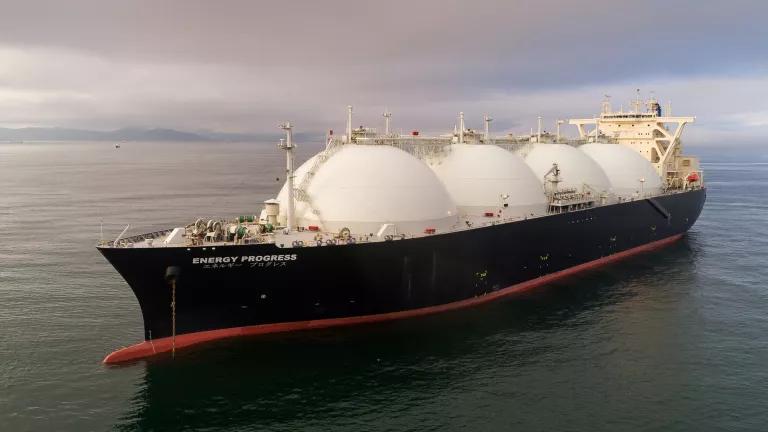
A liquefied natural gas (LNG) tanker in the Sea of Japan near Nakhodka, Russia
Vladimir Serebryanskiy/Dreamstime
Decades ago, the fossil fuel industry figured out how to transport gas by ocean liner, in its quest to open markets beyond the domestic U.S. pipeline network. Its trick—liquefying fracked natural gas—was a boon for energy companies, but it’s been bad for the rest of us. Liquefied natural gas (LNG) isn’t just the same climate-destroying energy source in a different state of matter; it’s actually worse than ordinary (unliquefied) gas. The energy required to chill, ship, and regasify the fossil fuel makes it far more carbon-intensive and increases the potential for leakage of dangerous methane. In addition, locking in this fossil fuel for the coming decades, through massive, long-term infrastructure projects, could make it impossible to limit global warming to 1.5 degrees Celsius.
Despite ample scientific evidence and growing public backlash about its dangers to our climate, health, and communities, the liquefied natural gas industry is now bent on expanding. Here’s what you need to know about LNG as our federal government takes a fresh look at its massive environmental impacts.
What is liquefied natural gas?
The fossil fuel known as “natural gas” or “fossil gas”—the stuff frackers are after—exists in a gaseous state at room temperature. This presents a problem for transport. Since gases are made up of lots of empty space with just a few molecules bouncing around, it would take a massive container to ship a useful amount of gas by road or rail. That leaves pipelines as the primary means for transporting gas at room temperature.
Enter liquefied natural gas (LNG). By cooling fracked natural gas to -259 degrees Fahrenheit—a very energy-intensive undertaking—processors can transform it into a denser liquid. (For context, the coldest temperature ever recorded outdoors on earth is -135.8 degrees Fahrenheit.) This liquid is then loaded into specialized oceangoing containers, which look like gigantic domes rising from the ship’s deck.
Shippers have a trick to keep the LNG cold and in a liquid state during its long maritime journey. To understand it, first think of a pot of boiling water. When you add more heat, the water doesn’t get hotter, because you can’t heat liquid water above its boiling point. Instead, the added energy converts a small amount of the liquid into steam, which floats out of the pot.
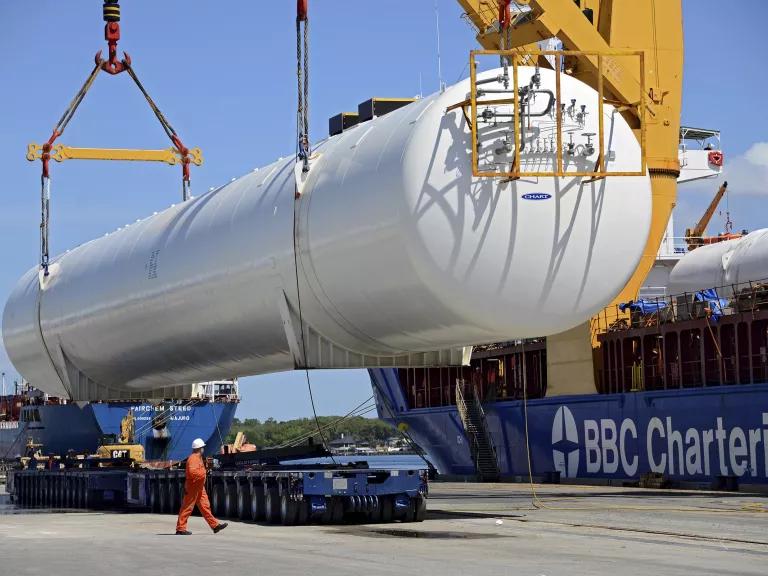
A 265,000-gallon tank being installed at Eagle LNG's ship fueling operation at JAXPORT in Jacksonville, Florida
Bob Mack/Florida Times-Union via AP
The same thing happens on the LNG carrier. The product is loaded onto the ship at its condensation point of -259 degrees Fahrenheit. As the storage container absorbs heat from the outside air, that energy goes toward converting small amounts of the LNG back into its gaseous form. The regasified molecules are directed out of the storage container and into the ship’s engines, where they power the ship. Most of the LNG, however, remains in its liquid state until it reaches its destination, where it is regasified and transported through pipelines to consumers.
“LNG is basically just very cold gas,” says Amanda Levin, director of policy analysis in NRDC’s Science Office. “You don’t typically use LNG directly. It’s about how you transport it, which is one reason it’s carbon-intensive.”
What is liquefied natural gas used for?
Once LNG is regasified at room temperature, it is used the same way as any natural gas—it is burned to generate electricity, heat, and cooking fuel in homes and businesses, as well as processed for plastics or other petrochemical products. LNG can also be used as a vehicle fuel without being returned to its gaseous form. But, since holding the liquid at -259 degrees Fahrenheit is no easy task, LNG’s transport use is limited to a small number of heavy-duty trucks, buses, and ships.
Power plants also use LNG as a backup fuel. By cooling gas, utilities are able to store LNG on-site in cryogenic tanks. When demand peaks, or supply drops due to limited pipeline availability, the utility returns the LNG to its gaseous state and burns it to generate electricity.
What are the differences between raw, compressed, and liquefied natural gas?
Raw natural gas is the name for unprocessed natural gas that has just been pumped from the ground. Because raw natural gas is unprocessed, it contains several components (like water, nitrogen, and carbon dioxide) that have to be removed.
Once the natural gas has been separated into its useful parts, there are two ways to make it dense enough to transport: compressing it or liquefying it.
Compressed natural gas (CNG) is gas that has been physically stuffed into a chamber, which is then gradually shrunk. CNG has 100 times as much energy as the same volume of uncompressed gas and can be stored at room temperature.
Liquefied natural gas, as mentioned, is chilled and liquefied gas held at very cold temperatures. Although LNG comes with storage and transport challenges, it is much more energy dense than compressed natural gas—and about 600 times more energy dense than ordinary gas.
The liquefied natural gas industry
The commercial production of LNG in the United States began in 1941, with the first U.S. exports heading to the United Kingdom in the late 1950s. But the real boom for U.S. LNG kicked off far more recently.
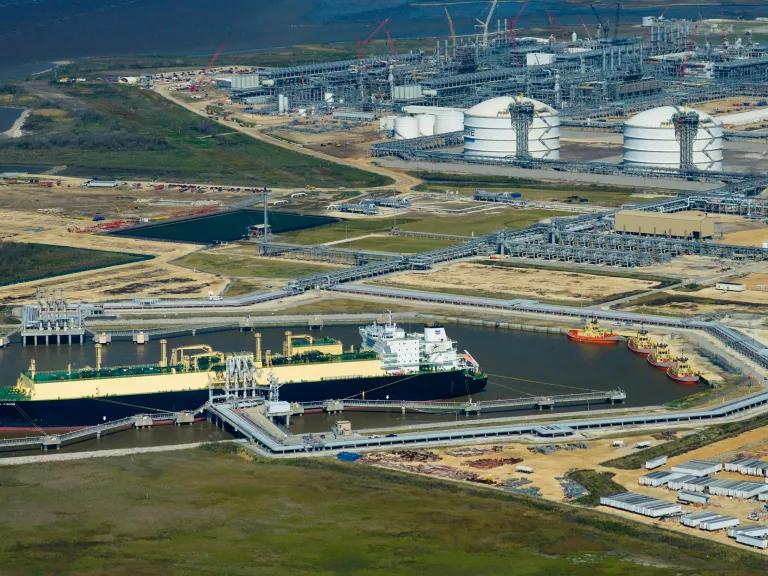
Cheniere Energy’s Sabine Pass LNG facility in Cameron Parish, Louisiana
Lindsey Janies/Bloomberg via Getty Images
The increase in U.S. natural gas extraction—which far exceeds domestic demand for gas—has spurred the industry to build out LNG infrastructure, such as processing facilities and export terminals to ease shipping of the fossil fuel. U.S. exports of LNG grew a staggering 450 percent between 2017 and 2022. The United States is now the world’s biggest LNG exporter (followed by Australia, Qatar, and Russia), hitting a record 12.4 billion cubic feet per day (Bcf/d) in October 2023—almost 10 percent of total U.S. gas production.
Some of that increase has to do with geopolitical issues. For example, ever since Russia invaded Ukraine, the European Union has used investments in energy efficiency and clean energy, among other strategies, to cut Russian gas imports from 41 percent of its total imports down to 8 percent. At the same time, U.S. LNG exports to Europe nearly doubled, making the United States its largest supplier.
But ultimately, the final destination of a U.S. tanker of LNG might be influenced by where the company can get the highest prices. While Europe has been the main destination for recent exports, the vast majority of U.S. LNG contracts signed in 2022 and 2023 have unspecified destinations. Analysts have found that most of these new contracts are ending up in the hands of LNG resellers. These buyers, typically oil and gas companies or gas traders, will look to profit off of whichever country, company, or project offers the most money for the product.
Unfortunately, these lucrative overseas exports are now contributing to higher home-heating costs across the United States. As the demand for gas has rebounded from pandemic lows, both globally and in the United States, the U.S. LNG industry remains focused on maximizing shareholder returns rather than meeting the domestic market demand—and so costs to consumers have risen. “Unlike oil, which is priced on a global market, natural gas prices reflect domestic supply and demand,” explains Gillian Giannetti, a senior attorney with NRDC’s Climate & Energy program. “LNG exports put upward pressure on gas bills for U.S. consumers, forcing them to compete with overseas customers for gas produced in this country.”
Liquefied natural gas environmental concerns
LNG and environmental justice
There are many ways in which the gas industry can harm communities and ecosystems: water contamination around fracking sites, abandoned wells that send a stream of harmful pollution into the air, gas-fueled stoves that worsen in-home air quality, increased risk of explosions and deadly accidents, to name a few. But from the Delaware River Basin in New Jersey to Cameron Parish, Louisiana, the list of proposed LNG facilities is getting longer. “Most of these facilities are being built to process and ship gas abroad—at the cost of the health, safety, and well-being of local communities,” says Giannetti. “And as with other fossil fuel infrastructure, these facilities are disproportionately and deliberately sited in low-income neighborhoods and in communities of color.”
This is especially true along the Gulf Coast in Louisiana and Texas, where the majority of existing and proposed LNG projects are located. As Anne Rolfes, director of the Louisiana Bucket Brigade, explained to the Environmental Integrity Project: “The LNG terminals proposed for Louisiana sacrifice [residents’ and workers’] health and the very existence of our coast for the worthless goal of exporting gas. We are an impoverished state, and these projects built in flood zones make us poorer and more vulnerable.”
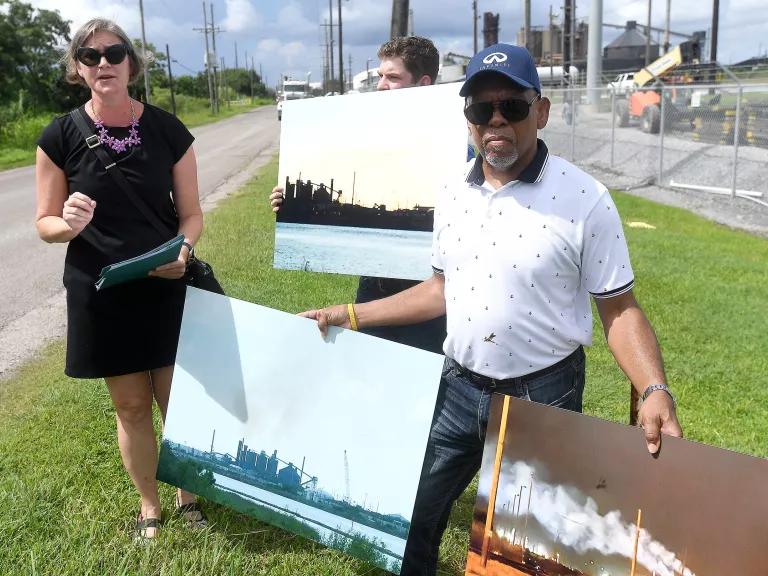
Port Arthur Community Action Network (PACAN) founder, John Beard (front), stands with Lone Star Legal Aid's Amy Dinn and Chase Porter at a PACAN press conference outside of the Oxbow calcining plant in West Port Arthur, Texas, on August 18, 2021.
Kim Brent/The Beaumont Enterprise
Many communities have been pushing back, demanding not to be treated as sacrifice zones by the gas industry or by those that review these projects. “We must begin to treat each other and see each other as human beings and not as commodities—or the land upon which we live as a commodity to be used and exploited for profit and gain for the few, over the needs of the many,” said John Beard Jr., founder of the Texas-based Port Arthur Community Action Network, at a roundtable on environmental justice and infrastructure permitting, hosted by the Federal Energy Regulatory Commission (FERC) in March 2023. “Port Arthur is a city that has suffered in this way for over 12 decades of environmental pollution.” The majority-Black community of more than 55,000 residents is home to two LNG export facilities as well as some of the largest oil refineries in the United States. Beard went on to note that the city has twice the national average rate of cancer, heart, lung, and kidney disease. Not only does heavy industrial air pollution affect public health in Port Arthur, but the community’s proximity to the coast makes residents especially vulnerable to the stronger hurricanes brought on by climate change.
LNG and climate change
In addition to the health and environmental risks it poses, natural gas, in any form, contributes to climate change. Burning gas for energy releases carbon into the atmosphere, which fuels global warming. And in every step of its life cycle—from extraction and processing to storage and transportation—LNG emits methane. As a greenhouse gas, methane is 85 times more potent than carbon dioxide in the first 20 years after it is emitted.
LNG is an especially problematic form of natural gas for the climate. Chilling gas to incredibly cold temperatures uses a lot of energy. Holding it at that temperature uses energy. Transporting it by ship, rail, and truck uses energy. Warming it back up uses a lot of energy. When you add all of that together, LNG is responsible for about twice as much greenhouse gas as ordinary gas. Fourteen percent of the climate footprint of LNG comes from gas leaks, flaring, or intentional venting (for example, when operators release gas into the atmosphere to allow for maintenance on a pipe) during production and transport.
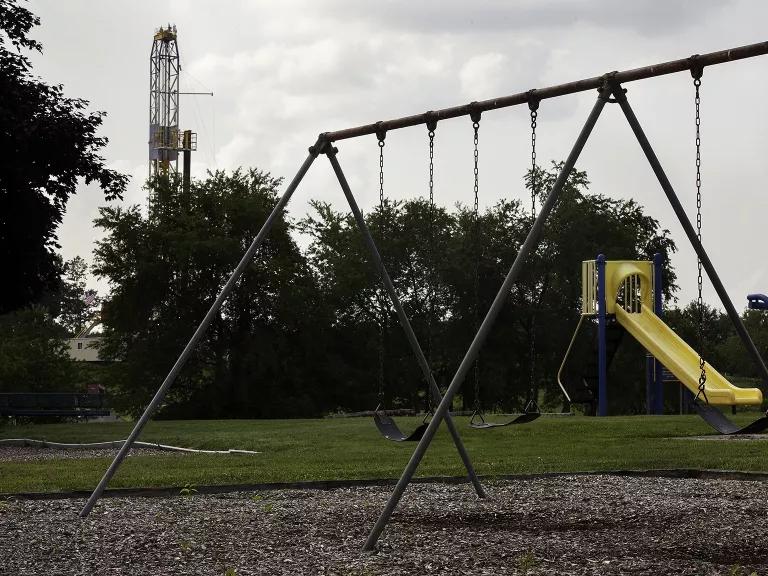
A fracking rig looms over the playground of Summit Elementary school in Butler, Pennsylvania.
Steven Rubin for Public Herald, CC BY-NC-ND 4.0
“As bad as that sounds, comparing LNG to ordinary natural gas isn’t even the right comparison,” explains Levin. “We should be comparing it to renewables.” To produce the same amount of energy, LNG emits 14 times as much carbon as solar power, and 50 times as much carbon as wind power.
LNG poses a special problem to the United States from a carbon-accounting perspective. Since LNG intended for export would be extracted and chilled in the United States, all of the energy required to complete those steps counts toward U.S. carbon emissions—as well as up to 40 percent of the emissions of the exported fuel itself—even though the energy will be consumed abroad.
The United States is already substantially behind on the commitment we made through the Paris Agreement to reduce greenhouse gas emissions by 50 percent to 52 percent by 2030 compared to 2005 levels.
The future of liquefied natural gas is in question
With awareness of the many threats that LNG expansion poses, public pressure has mounted for lawmakers to intervene. And in January 2024, the Biden administration announced it is pausing pending approvals for new LNG export authorizations to non–Free Trade Agreement countries in order to re-evaluate how these exports impact high consumer energy costs domestically, as well as greenhouse gas emissions.
“Federal law requires FERC and the U.S. Department of Energy (DOE) to evaluate whether a proposed LNG project is consistent with the public interest and to quantify and assess the environmental effects of an LNG project,” says Giannetti. “But historically, the LNG review process has been little more than a check-the-box exercise.” (FERC reviews applications to build pipelines and liquefaction terminals, while the DOE reviews applications to export the commodity to other countries. The Biden administration’s action is related to the DOE’s reviews.)
This pause is a much-needed reality check for an industry that’s already overbuilt, with companies racing to to profit in the face of overwhelming scientific opposition and to the detriment of the communities surrounding gas production and transportation projects. “The proposed projects that the Biden administration is reviewing now would not begin operating until 2028, at the earliest,” says Giannetti. “That’s the worst possible time to lock future generations into decades more of dependence on fossil fuels.”
Phasing out fossil fuels in order to avoid climate catastrophe, as global leaders committed to at COP28 in Dubai, requires oil and gas consumption to fall by more than 5 percent a year, on average, between now and 2050. And to meet its legally mandated climate commitments, Europe, currently the largest importer of U.S. LNG, will need to drop its gas consumption by at least 26 percent below today’s levels.
“In LNG, the fossil fuel industry has found yet another way to push a product we should already be moving away from,” says Levin. “It’s simply not where we need to go.”
This story was originally published on January 4, 2022 and has been updated with new information and links.
This NRDC.org story is available for online republication by news media outlets or nonprofits under these conditions: The writer(s) must be credited with a byline; you must note prominently that the story was originally published by NRDC.org and link to the original; the story cannot be edited (beyond simple things such as grammar); you can’t resell the story in any form or grant republishing rights to other outlets; you can’t republish our material wholesale or automatically—you need to select stories individually; you can’t republish the photos or graphics on our site without specific permission; you should drop us a note to let us know when you’ve used one of our stories.
The U.S. is the world’s largest exporter of dangerous liquefied natural gas.
Tell the Biden administration you support its pause on LNG exports—and that you’re counting on it to phase out all dirty fuels and to fight the climate crisis.
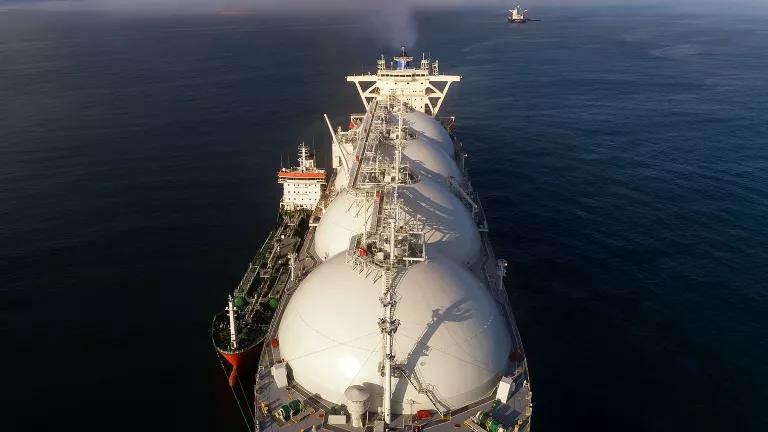
Help protect communities from dangerous liquefied natural gas!
Liquefied natural gas (LNG) is a dangerous substance composed primarily of methane, a greenhouse gas 80 times more potent than carbon dioxide. The Biden administration has paused LNG exports—and now we must urge it to phase out all climate-wrecking fuels.

What Are the Solutions to Climate Change?
What Are the Causes of Climate Change?
Fossil Fuels: The Dirty Facts